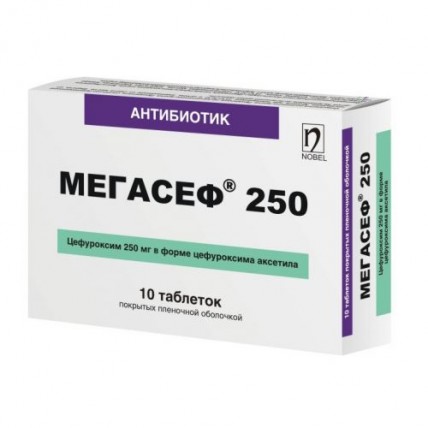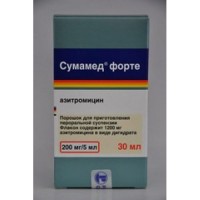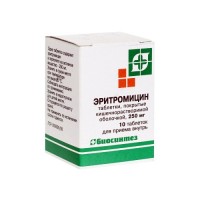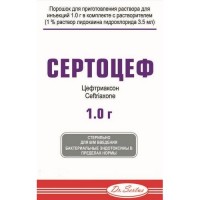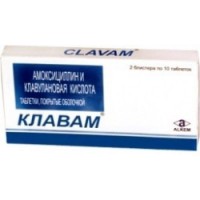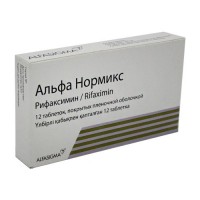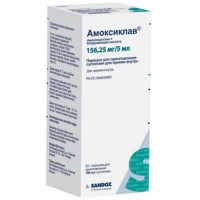Megasef 250 mg (10 tablets)
- $20.20
The instruction for medical use
of medicine Мегасеф® 250 Мегасеф® 500
the Trade name
Мегасеф® 250 Мегасеф® 500
International unlicensed
name Tsefuroksim Lekarstvennaya
the Tablet form, film coated 250 mg or 500 mg
Structure
One tablet contains
active substances: the tsefuroksima aksetit 300.72 (it is equivalent to a tsefuroksim 250.0) and 601.44 (it is equivalent to a tsefuroksim 500.0),
excipients: prezhelatinizirovanny starch, krospovidon (Kollidon Cl), sodium of a kroskarmelloz, sodium lauryl sulfate, magnesium stearate, silicon dioxide colloidal anhydrous (Aerosil 200),
film cover: material for cover No. 1 of Sepifilm LP 770, the water purified
structure of a film cover: a gipromelloza (methylhydroxypropyl cellulose) (E464), cellulose microcrystalline (E460), stearic acid (E570)
of the titan dioxide (E171)
the Description
of the Tablet, film coated white color, oblong shape, with marking of NOBEL on one party and risky on another
Pharmacotherapeutic group
Antimicrobial drugs for system use. Antibacterial drugs for system use. Cephalosporins of the second generation
the Code of automatic telephone exchange J01DC02
aksetit the Pharmacological Tsefuroksim Pharmacokinetics properties quickly is soaked up from digestive tract and hydrolyzed by nonspecific esterases of a mucous membrane of intestines and blood to a tsefuroksim. Linking with proteins of plasma makes 50%. Tsefuroksim is distributed in fabrics and liquids of an organism. At administration of drug after a meal the maximum concentration in plasma for dosages of 125 mg, 250 mg and 500 mg makes according to 2.1 mkg/ml, 4.1 mkg/ml, 7 mkg/ml. The maximum concentration is reached 3 hours later after administration of drug. Therapeutic concentration in cerebrospinal fluid are reached only in meningitis. Gets through a placenta, it is allocated with breast milk. It is removed with urine in not changed look. Elimination half-life about 1.2 hours.
A pharmacodynamics
Tsefuroksim – a tsefalosporinovy antibiotic of the second generation of a broad spectrum of activity. Has bactericidal effect at the expense of inhibition of synthesis of a cell wall of bacteria. Tsefuroksim acetylates membrane-bound transpeptidases, breaking, thus, the cross stitching of peptido-glycanes necessary for ensuring durability and rigidity of a cell wall. Tsefuroksim is resistant to action of many bacterial beta laktamaz therefore he is active concerning the majority of species of microorganisms resistant to penicillin and amoxicillin.
Tsefuroksim is active concerning the following microorganisms:
Gram-negative bacteria: Escherichia coli, Haemophilus influenzae (including the types producing beta lactamelements), Haemophilus parainfluenzae, Klebsiella pneumoniae, Moraxella catarrhalis (including the types producing beta lactamelements), Neisseria gonorrhoeae (including the types producing beta lactamelements), Salmonella spp., Shigella spp., Proteus mirabilis, Enterobacter spp.
Gram-positive bacteria: Staphylococcus aureus (including the types producing beta lactamelements), Streptococcus pneumoniae, Streptococcus pyogenes.
Certain types of enterococci, for example Enterococcus faecalis, are resistant to a tsefuroksim.
Anaerobe bacterias: Peptococcus spp., Peptostreptococcus spp., Clostridium spp., Bacteroides spp., Fusobacterium spp.
Indications
- an acute bronchitis, exacerbation of chronic bronchitis, pneumonia
- otitis, sinusitis, tonsillitis, pharyngitis
- pyelonephritis, cystitis, an urethritis
- abdominal infections
- gynecologic infections
- infections of bones and joints
- infections of skin and soft tissues.
The route of administration and doses
the Recommended dose for adults and children are more senior than 12 years makes 250 mg 2 times a day. In heavier infections or infections caused by less sensitive microorganisms 500 mg 2 times a day are recommended. In uncomplicated infections of urinary tract the recommended dose makes 250 mg once a day. If necessary at some patients with infections of urinary tract the dosage can be increased up to 250 mg 2 times a day. The maximum daily dose for adults – 6 g.
Usually duration of treatment is 7 days (from 5 to 10 days). The course of treatment has to be increased up to 10 days at patients with the infections caused by a beta and hemolytic streptococcus for avoidance of developing of acute rheumatic fever or an acute glomerulonephritis.
To patients with a renal failure the mode of dosing is set taking into account values of clearance of creatinine.
For the best absorption the drug should be taken after a meal. Tablets should be swallowed entirely, without chewing therefore to children 12 years are younger it is possible to use drug in an injection form.
Side effects
Often (≥1/100, & lt, 1/10)
- an eosinophilia
- a headache
- nausea, diarrhea
- short-term increase in level of liver enzymes (ALT, nuclear heating plant, LDG)
Infrequently (≥1/1000, & lt, 1/100)
- vomiting
- eczema
- positive take of the test of Koombs, thrombocytopenia, a leukopenia (sometimes expressed)
is rare (≥1/10000, & lt, 1/1000)
- pseudomembranous colitis
- urticaria, an itching
Very seldom (& lt, 1/10000)
- hemolytic anemia
- medicinal fever, a serum disease, an anaphylaxis, a multiformny erythema, Stephens-Johnson's syndrome, a toxic epidermal necrolysis
- jaundice (generally cholestatic),
Contraindication hepatitis
- hypersensitivity to antibiotics of a tsefalosporinovy row, penicillin, karbapinema
- children's age up to 12 years
- the first trimester of pregnancy
Medicinal interactions
of Megasef® is not active in a GIT, has the minimum impact on indestinal flora and synthesis of vitamin K. At a concomitant use strengthens anticoagulating effect of warfarin.
At simultaneous use with loopback diuretics the risk of development of nephrotoxic action increases.
Probenetsid competes with the drug Megasef® at renal canalicular secretion that leads to increase in concentration of a tsefuroksim in plasma.
In blood plasma at the patients accepting Megasef® it is recommended to apply glyukozoksidazny or hexokinase methods to determination of level of glucose.
Мегасеф® does not influence creatinine level in serum and in urine.
Special instructions
With care apply in the profound renal failures, at instructions in the anamnesis on colitis.
At patients with hypersensitivity to penicillin allergic reactions to antibiotics of a tsefalosporinovy row are possible. At emergence of the significant allergic reaction to Megasef® it is necessary to cancel drug, to appoint the corresponding treatment, in especially hard cases there can be a need for holding resuscitation actions.
Long use of drug, as well as other antibiotics of a broad spectrum of activity, can lead to the strengthened reproduction of microorganisms, insensitive to drug (for example, Candida, Enterococci, Clostridium difficile) in this connection there can be a need of drug withdrawal. At use of antibiotics of a broad spectrum of activity the development of pseudomembranous colitis is possible, it needs to be meant at emergence at patients of diarrhea in time or after performing antibacterial therapy.
During treatment the positive forward reaction of Koombs and false positive reaction of urine to glucose is possible.
Pregnancy and the period of a lactation
Use in II and III trimesters of pregnancy, and also in the period of a lactation perhaps in cases when the expected advantage of therapy for mother exceeds potential risk for a fruit.
Features of influence of medicine on ability to run the vehicle or potentially dangerous mechanisms.
Are not established.
Overdose
Symptoms: excitement of central nervous system, spasm.
Treatment: symptomatic treatment, peritoneal and hemodialysis.
The form of release and packing
On 10 tablets place in blister strip packaging from a film of polyvinylchloride and printing aluminum foil.
On 1 planimetric packing together with the instruction for medical use in the state and Russian languages place in a pack cardboard with the hologram of firm – producer.
To Store storage conditions at a temperature not above 25 °C in the dry, protected from light place.
To store out of children's reach!
3 years
not to apply a period of storage after an expiration date.
Prescription status
According to the prescription
Republic of Kazakhstan JSC Nobel Almatinskaya Pharmatsevticheskaya Fabrika Producer
Almaty, Shevchenko St. 162 E.
The owner of the registration certificate
of JSC Nobel Almatinskaya Pharmatsevticheskaya Fabrika
the Republic of Kazakhstan
the Address of the organization accepting in the territory of the Republic of Kazakhstan claims from consumers on quality of products (goods):
JSC Nobel Almatinskaya Pharmatsevticheskaya Fabrika
Republic of Kazakhstan, Almaty, Shevchenko St. 162 E.
Phone number: (+7 727) 399-50-50
Fax number: (+7 727) 399-60-60
To develop the e-mail address of nobel@nobel.kz
of medicine Мегасеф® 250 Мегасеф® 500
the Trade name
Мегасеф® 250 Мегасеф® 500
International unlicensed
name Tsefuroksim Lekarstvennaya
the Tablet form, film coated 250 mg or 500 mg
Structure
One tablet contains
active substances: the tsefuroksima aksetit 300.72 (it is equivalent to a tsefuroksim 250.0) and 601.44 (it is equivalent to a tsefuroksim 500.0),
excipients: prezhelatinizirovanny starch, krospovidon (Kollidon Cl), sodium of a kroskarmelloz, sodium lauryl sulfate, magnesium stearate, silicon dioxide colloidal anhydrous (Aerosil 200),
film cover: material for cover No. 1 of Sepifilm LP 770, the water purified
structure of a film cover: a gipromelloza (methylhydroxypropyl cellulose) (E464), cellulose microcrystalline (E460), stearic acid (E570)
of the titan dioxide (E171)
the Description
of the Tablet, film coated white color, oblong shape, with marking of NOBEL on one party and risky on another
Pharmacotherapeutic group
Antimicrobial drugs for system use. Antibacterial drugs for system use. Cephalosporins of the second generation
the Code of automatic telephone exchange J01DC02
aksetit the Pharmacological Tsefuroksim Pharmacokinetics properties quickly is soaked up from digestive tract and hydrolyzed by nonspecific esterases of a mucous membrane of intestines and blood to a tsefuroksim. Linking with proteins of plasma makes 50%. Tsefuroksim is distributed in fabrics and liquids of an organism. At administration of drug after a meal the maximum concentration in plasma for dosages of 125 mg, 250 mg and 500 mg makes according to 2.1 mkg/ml, 4.1 mkg/ml, 7 mkg/ml. The maximum concentration is reached 3 hours later after administration of drug. Therapeutic concentration in cerebrospinal fluid are reached only in meningitis. Gets through a placenta, it is allocated with breast milk. It is removed with urine in not changed look. Elimination half-life about 1.2 hours.
A pharmacodynamics
Tsefuroksim – a tsefalosporinovy antibiotic of the second generation of a broad spectrum of activity. Has bactericidal effect at the expense of inhibition of synthesis of a cell wall of bacteria. Tsefuroksim acetylates membrane-bound transpeptidases, breaking, thus, the cross stitching of peptido-glycanes necessary for ensuring durability and rigidity of a cell wall. Tsefuroksim is resistant to action of many bacterial beta laktamaz therefore he is active concerning the majority of species of microorganisms resistant to penicillin and amoxicillin.
Tsefuroksim is active concerning the following microorganisms:
Gram-negative bacteria: Escherichia coli, Haemophilus influenzae (including the types producing beta lactamelements), Haemophilus parainfluenzae, Klebsiella pneumoniae, Moraxella catarrhalis (including the types producing beta lactamelements), Neisseria gonorrhoeae (including the types producing beta lactamelements), Salmonella spp., Shigella spp., Proteus mirabilis, Enterobacter spp.
Gram-positive bacteria: Staphylococcus aureus (including the types producing beta lactamelements), Streptococcus pneumoniae, Streptococcus pyogenes.
Certain types of enterococci, for example Enterococcus faecalis, are resistant to a tsefuroksim.
Anaerobe bacterias: Peptococcus spp., Peptostreptococcus spp., Clostridium spp., Bacteroides spp., Fusobacterium spp.
Indications
- an acute bronchitis, exacerbation of chronic bronchitis, pneumonia
- otitis, sinusitis, tonsillitis, pharyngitis
- pyelonephritis, cystitis, an urethritis
- abdominal infections
- gynecologic infections
- infections of bones and joints
- infections of skin and soft tissues.
The route of administration and doses
the Recommended dose for adults and children are more senior than 12 years makes 250 mg 2 times a day. In heavier infections or infections caused by less sensitive microorganisms 500 mg 2 times a day are recommended. In uncomplicated infections of urinary tract the recommended dose makes 250 mg once a day. If necessary at some patients with infections of urinary tract the dosage can be increased up to 250 mg 2 times a day. The maximum daily dose for adults – 6 g.
Usually duration of treatment is 7 days (from 5 to 10 days). The course of treatment has to be increased up to 10 days at patients with the infections caused by a beta and hemolytic streptococcus for avoidance of developing of acute rheumatic fever or an acute glomerulonephritis.
To patients with a renal failure the mode of dosing is set taking into account values of clearance of creatinine.
For the best absorption the drug should be taken after a meal. Tablets should be swallowed entirely, without chewing therefore to children 12 years are younger it is possible to use drug in an injection form.
Side effects
Often (≥1/100, & lt, 1/10)
- an eosinophilia
- a headache
- nausea, diarrhea
- short-term increase in level of liver enzymes (ALT, nuclear heating plant, LDG)
Infrequently (≥1/1000, & lt, 1/100)
- vomiting
- eczema
- positive take of the test of Koombs, thrombocytopenia, a leukopenia (sometimes expressed)
is rare (≥1/10000, & lt, 1/1000)
- pseudomembranous colitis
- urticaria, an itching
Very seldom (& lt, 1/10000)
- hemolytic anemia
- medicinal fever, a serum disease, an anaphylaxis, a multiformny erythema, Stephens-Johnson's syndrome, a toxic epidermal necrolysis
- jaundice (generally cholestatic),
Contraindication hepatitis
- hypersensitivity to antibiotics of a tsefalosporinovy row, penicillin, karbapinema
- children's age up to 12 years
- the first trimester of pregnancy
Medicinal interactions
of Megasef® is not active in a GIT, has the minimum impact on indestinal flora and synthesis of vitamin K. At a concomitant use strengthens anticoagulating effect of warfarin.
At simultaneous use with loopback diuretics the risk of development of nephrotoxic action increases.
Probenetsid competes with the drug Megasef® at renal canalicular secretion that leads to increase in concentration of a tsefuroksim in plasma.
In blood plasma at the patients accepting Megasef® it is recommended to apply glyukozoksidazny or hexokinase methods to determination of level of glucose.
Мегасеф® does not influence creatinine level in serum and in urine.
Special instructions
With care apply in the profound renal failures, at instructions in the anamnesis on colitis.
At patients with hypersensitivity to penicillin allergic reactions to antibiotics of a tsefalosporinovy row are possible. At emergence of the significant allergic reaction to Megasef® it is necessary to cancel drug, to appoint the corresponding treatment, in especially hard cases there can be a need for holding resuscitation actions.
Long use of drug, as well as other antibiotics of a broad spectrum of activity, can lead to the strengthened reproduction of microorganisms, insensitive to drug (for example, Candida, Enterococci, Clostridium difficile) in this connection there can be a need of drug withdrawal. At use of antibiotics of a broad spectrum of activity the development of pseudomembranous colitis is possible, it needs to be meant at emergence at patients of diarrhea in time or after performing antibacterial therapy.
During treatment the positive forward reaction of Koombs and false positive reaction of urine to glucose is possible.
Pregnancy and the period of a lactation
Use in II and III trimesters of pregnancy, and also in the period of a lactation perhaps in cases when the expected advantage of therapy for mother exceeds potential risk for a fruit.
Features of influence of medicine on ability to run the vehicle or potentially dangerous mechanisms.
Are not established.
Overdose
Symptoms: excitement of central nervous system, spasm.
Treatment: symptomatic treatment, peritoneal and hemodialysis.
The form of release and packing
On 10 tablets place in blister strip packaging from a film of polyvinylchloride and printing aluminum foil.
On 1 planimetric packing together with the instruction for medical use in the state and Russian languages place in a pack cardboard with the hologram of firm – producer.
To Store storage conditions at a temperature not above 25 °C in the dry, protected from light place.
To store out of children's reach!
3 years
not to apply a period of storage after an expiration date.
Prescription status
According to the prescription
Republic of Kazakhstan JSC Nobel Almatinskaya Pharmatsevticheskaya Fabrika Producer
Almaty, Shevchenko St. 162 E.
The owner of the registration certificate
of JSC Nobel Almatinskaya Pharmatsevticheskaya Fabrika
the Republic of Kazakhstan
the Address of the organization accepting in the territory of the Republic of Kazakhstan claims from consumers on quality of products (goods):
JSC Nobel Almatinskaya Pharmatsevticheskaya Fabrika
Republic of Kazakhstan, Almaty, Shevchenko St. 162 E.
Phone number: (+7 727) 399-50-50
Fax number: (+7 727) 399-60-60
To develop the e-mail address of nobel@nobel.kz
